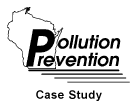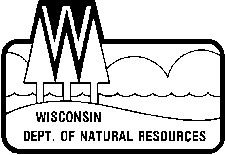
Fort McCoy
A Comprehensive Environmental Management Program to Minimize and Prevent Waste.
Hazardous Waste
- Paint Removal System
Replaced a sand-blasting paint removal system with an aluminum oxide pellet-blasting system in 1993. The metal pellets can be reused up to 15 times before being sent off-site for treatment and disposal as solid waste. The sand from the old system could not be reused and was considered hazardous waste because of the presence of heavy metals from the paints. The old system generated about 12 tons a week of hazardous waste as opposed to only one ton a week of hazardous waste with the new system.
Air Emissions
- Gas Furnace Conversion
Fort McCoy replaced between 3,000 and 4,000 coal-fired boilers with natural gas or liquid propane fuel furnaces between the years 1989 and 1995. This eliminated the use of 6,500 tons of coal per year. Subsequent reductions in emissions are summarized below.
Emission |
1990* |
1994* |
1995 |
Average Percent Reduction |
| Sulfur dioxide | 97 |
5 |
1 |
97% |
| Particulates | 61 |
5 |
3 |
93% |
| Nitrogen oxides | 23 |
2 |
13 |
67% |
| Carbon monoxide | 147 |
3 |
4 |
98% |
| Inhalable particulate matter | 12 |
3 |
3 |
75% |
| Reactive organic gas | 18 |
0.5 |
11 |
67% |
| * values are expressed in tons/year | ||||
- HVLP Paint Guns
Fort McCoy installed High Volume/Low Pressure (HVLP) paint guns that reduce overspray and Volatile Organic Compound (VOC) emissions by approximately 50 percent, or 8,750 pounds per year. This resulted in lower material costs, less solvent usage and fewer changes of paint booth filters.
Wastewater
- New Vehicle Wash Facility
Fort McCoy uses more than five million gallons of water per year to wash vehicles. Previously Fort McCoy discharged all of this water to its wastewater treatment plant, but has recently completed a new wash facility that reuses about 98 percent of the wash water. The wash water is collected, sent to settling basins, filtered and then reused. This process reduces loadings to the wastewater treatment plant and conserves water.
Solid Waste
- Land Application of Sludge
Fort McCoy began land-applying its wastewater treatment sludge to areas of the base undergoing revegetation work. Prior to this, the sludge had been disposed of at a solid waste landfill. To date, 466 tons of sludge has been land-applied. This has reduced landfill costs and extended the life of the landfill, while benefiting from a valuable soil conditioner. - Metal Recycling Program
Fort McCoy has established a metal recycling program for PCB-containing and non-PCB electrical transformers. Fort McCoy sends the PCB-containing equipment off-site where the fluid is drained and the casing is decontaminated. The oil is incinerated and the cleaned metal is then recycled. The non-PCB equipment can be directly recycled. The project has recycled approximately 100,000 pounds of valuable metals. - Motor Oil Absorbent Management
Fort McCoy had previously disposed of its clay based absorbent after each use. This material subsequently would be shipped off-site for landfill disposal. Since 1991, motor oil absorbent is reused on-site until the absorbent is fully saturated. The absorbent is then treated on-site in bio-piles. If significant reductions do not occur on-site, the material is shipped off-site for further biodegradation prior to thin spreading. This management strategy had reduced the total amount of absorbent used on-site therefore reducing the volume of material for treatment. - Recycling Motor Coolants
In 1996, Fort McCoy began recycling its motor coolants (anti-freeze). The coolants are collected and outside recycling vendor processes the recovered anti-freeze for reuse at the Fort.
- Paint Removal System
| Disposal Cost (old method) | $237,120/year |
| Disposal Cost (new method) | $19,750/year |
| Disposal Cost Savings | $217,370/year |
- High Volume/Low Pressure Paint Guns (HVLP)
| Approximate savings | $30,000/year |
- Land Application of Sludge
Type |
Old Process* |
New Process* |
Costs |
| Landfill tipping fees | $44.00 |
0 |
$44.00 |
| Labor | 0 |
($7.50) |
($7.50) |
| Equipment | 0 |
($7.00) |
($7.00) |
| *values are expressed per ton | Total | $29.50 |
|
| Cost Savings = 466 tons at $29.50/ton or $13,750 (to date) | |||
- Metal Recycling Program
| Estimated Disposal Cost Savings | $75,000, to date |
- Recycled Motor Oil Absorbent
| Approximate Savings | $17,850/year |
- Recycling Motor Coolants
Type |
Old Process |
New Process |
Costs |
| Product | $5.50 |
0 |
$5.50 |
| Disposal | $6.50 |
0 |
$6.50 |
| Recycle | 0 |
$2.00 |
($2.00) |
| * values are expressed per gallon | Total |
$10.00 |
|
| Cost savings = 315 gallons at $10/gal or $3,150 (to date) | |||
- Biodegradation of Petroleum-contaminated Soil
In 1995, Fort McCoy began experimenting with the use of naturally-occurring bacteria to biodegrade petroleum contamination in soil. The process involves mixing contaminated soil, wood chips (which serve as a bulking agent) and a nutrient source. This material is placed outdoors in covered rows and oxygen is supplied via perforated piping. The experiment is not yet complete and will require further adjustments to the moisture and oxygen content. If the project is able to remove sufficient petroleum contamination, Fort McCoy estimates that treatment through this method will cost $20 to $25 per ton, versus $50 per ton for asphalt incorporation. - Ultraviolet Disinfection
Currently, Fort McCoy uses chlorine to disinfect its wastewater. By early 1997, Fort McCoy will replace this system with one that uses ultraviolet light. The new system will eliminate an estimated 1,200 pounds per year of chlorine discharges to the environment. By changing this process, Fort McCoy eliminates Tier II (EPCRA) reporting requirement and saves on the procurement of chlorine and sulfur dioxide.
100 E. Headquarters Road
Fort McCoy, Wisconsin 54656-5263
608/388-4790
University of Wisconsin Extension
Solid and Hazardous Waste Education Center
Milwaukee area: 414/475-2845
Remainder of state: 608/262-0385
Industrial Waste
Reduction Information Clearinghouse
Wisconsin Department of Natural Resources
Bureau of Environmental Cooperative Assistance
608/267-9700 or e-mail: cea@dnr.state.wi.us
 |
TS-061 96 |